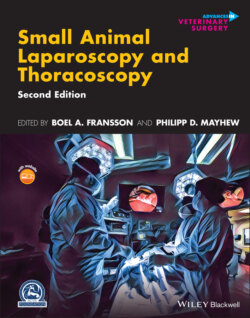Читать книгу Small Animal Laparoscopy and Thoracoscopy - Группа авторов - Страница 158
Anesthesia Considerations Related to Disease
ОглавлениеIn addition to routine procedures in healthy dogs and cats, animals with significant disease are increasingly presented for laparoscopy. The anesthetist must therefore be aware of the considerations related to the primary and any secondary disease processes in these patients. This information is available in broad based anesthesia textbooks. As an example, consider the patient presenting for a liver biopsy. On the surface, this would seem a fairly straightforward procedure. However, if circulation is compromised due to hypoproteinemia, acid–base and electrolyte changes, insufflation of the abdomen can result in serious hypotension. If coagulation status is also compromised, significant blood loss from the biopsy site may exacerbate this and the animal may require a transfusion. If lung metastases are present, respiratory complications are possible. The potential for side effects tends to increase with more complex procedures as in an animal with an adrenal pheochromocytoma where manipulation can increase catecholamine release and result in hypertension and cardiac rhythm abnormalities. Timely intervention is facilitated if these potential complications are anticipated.
Patients with significant cardiovascular and pulmonary disease (congenital heart defects, valvular heart disease, congestive heart failure, and pulmonary hypertension) are at a higher risk for complications related to the hemodynamic and ventilatory changes associated with the increase in intra‐abdominal pressure [28]. These patients may be unable to compensate, leading to further worsening of their condition [29]. Understanding the influence of the unique physiological effects of the laparoscopic approach on the pathophysiology of the disease process allows for adequate patient preparation and tailored perioperative monitoring and management to mitigate adverse outcomes [30, 31].
